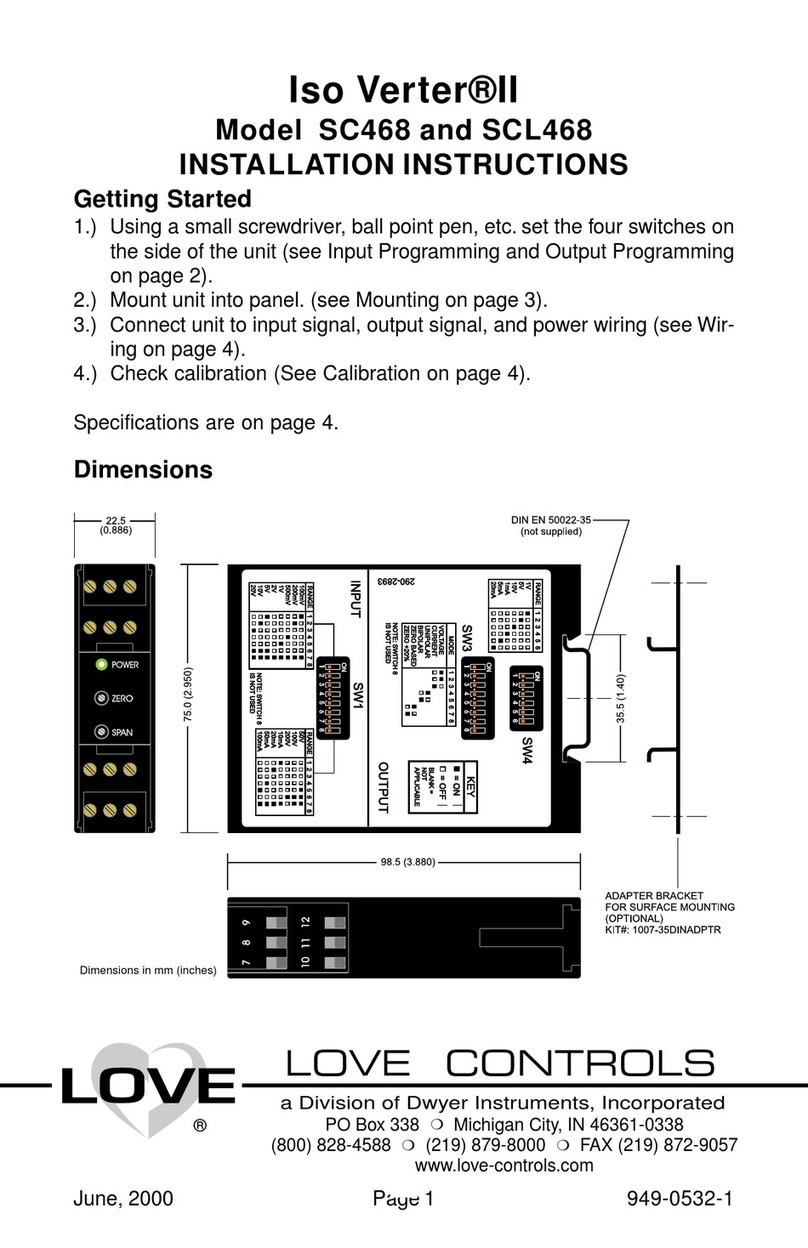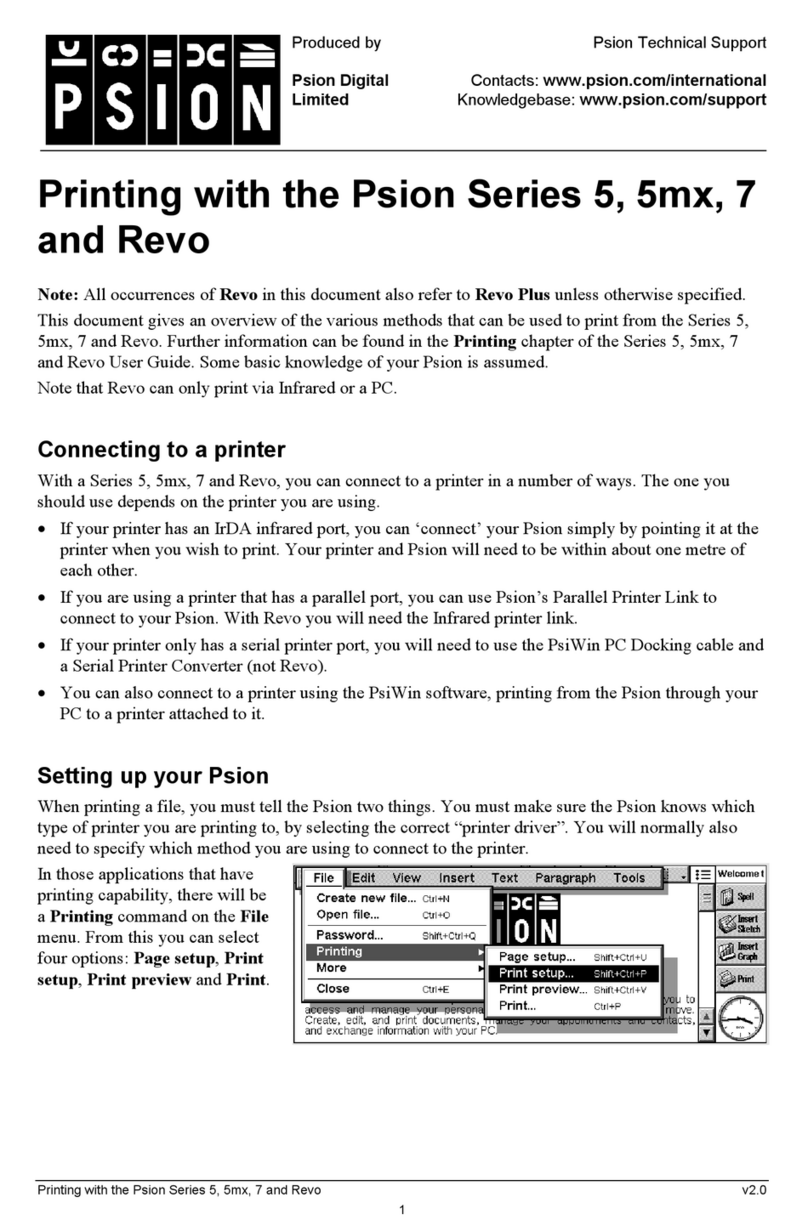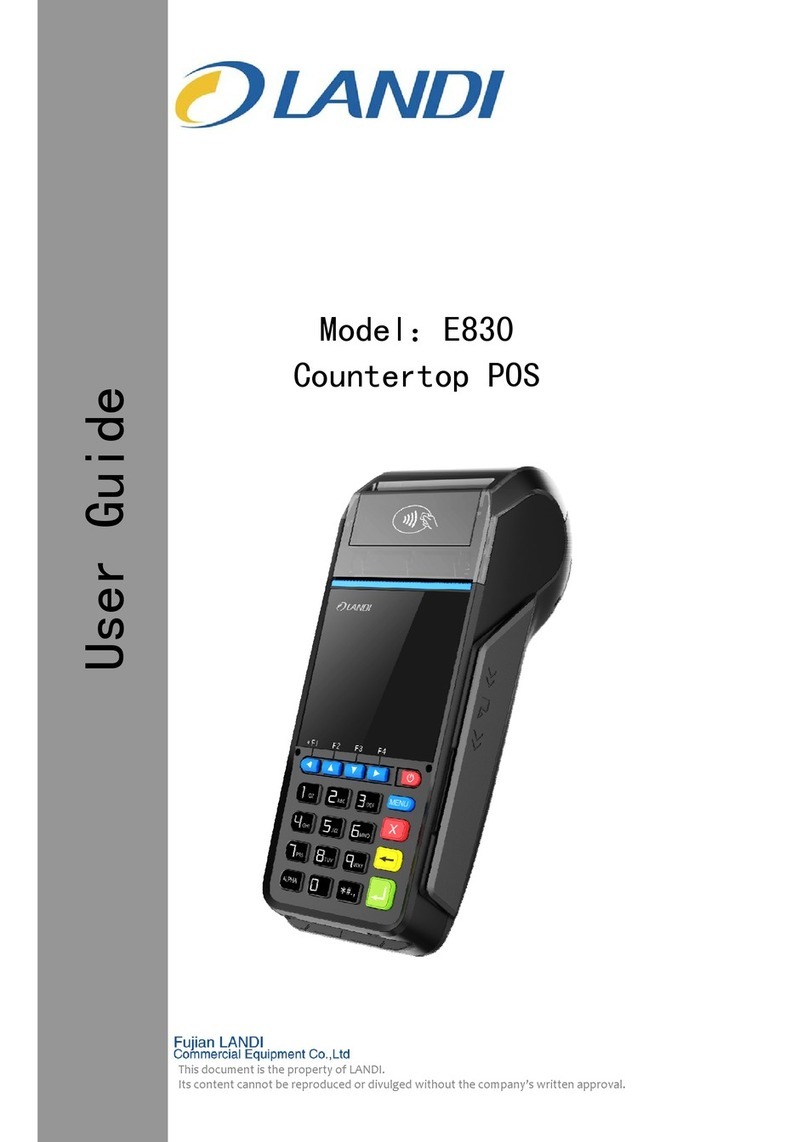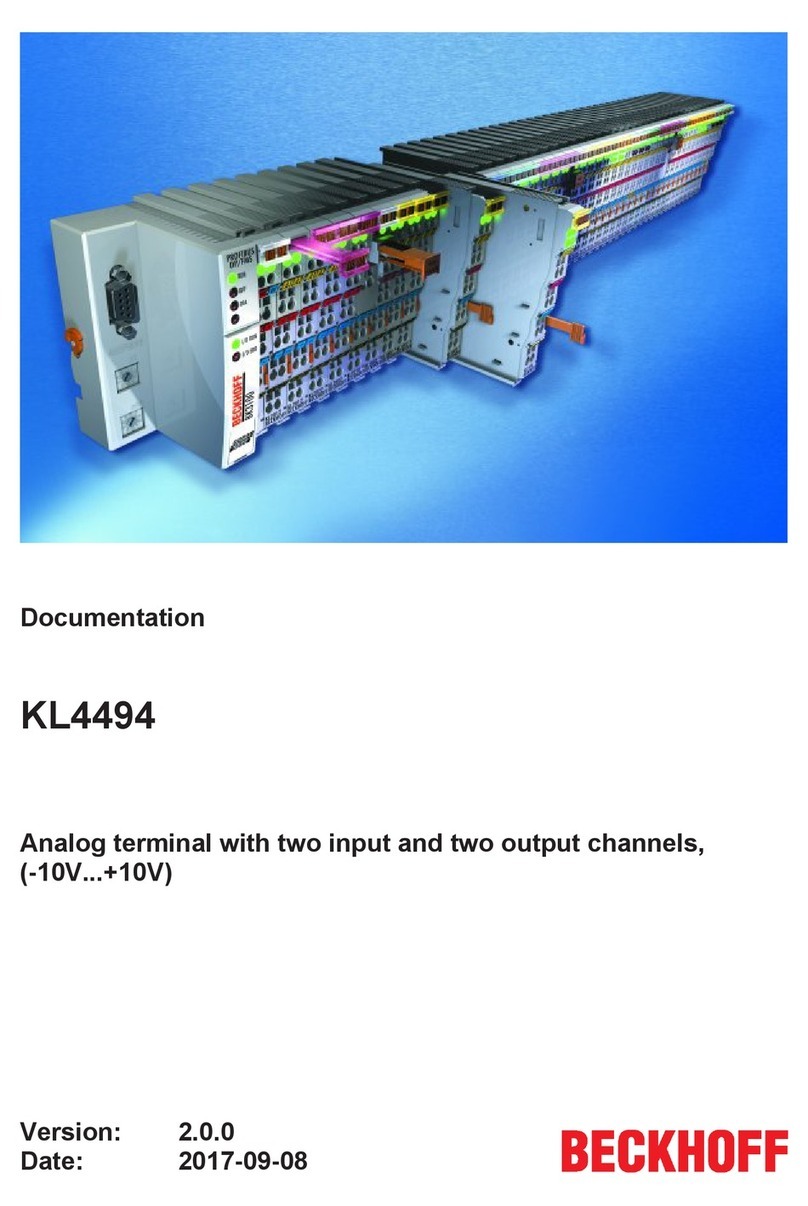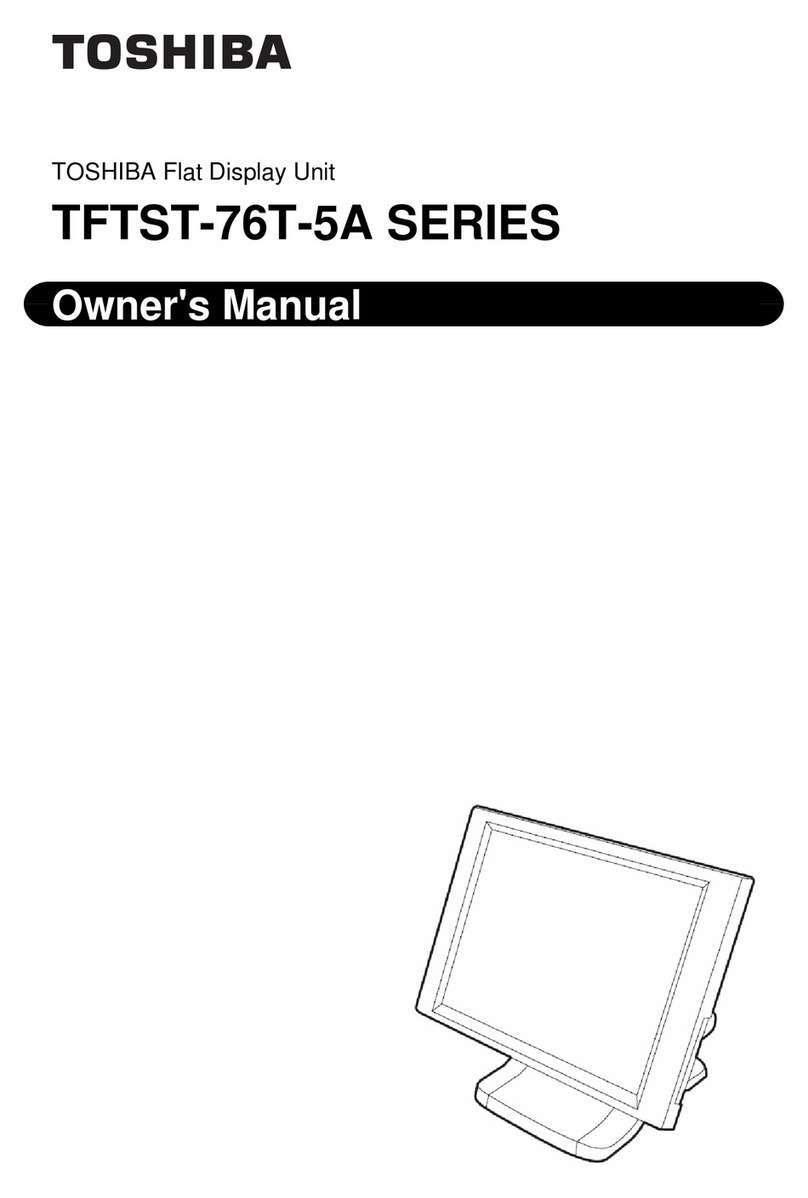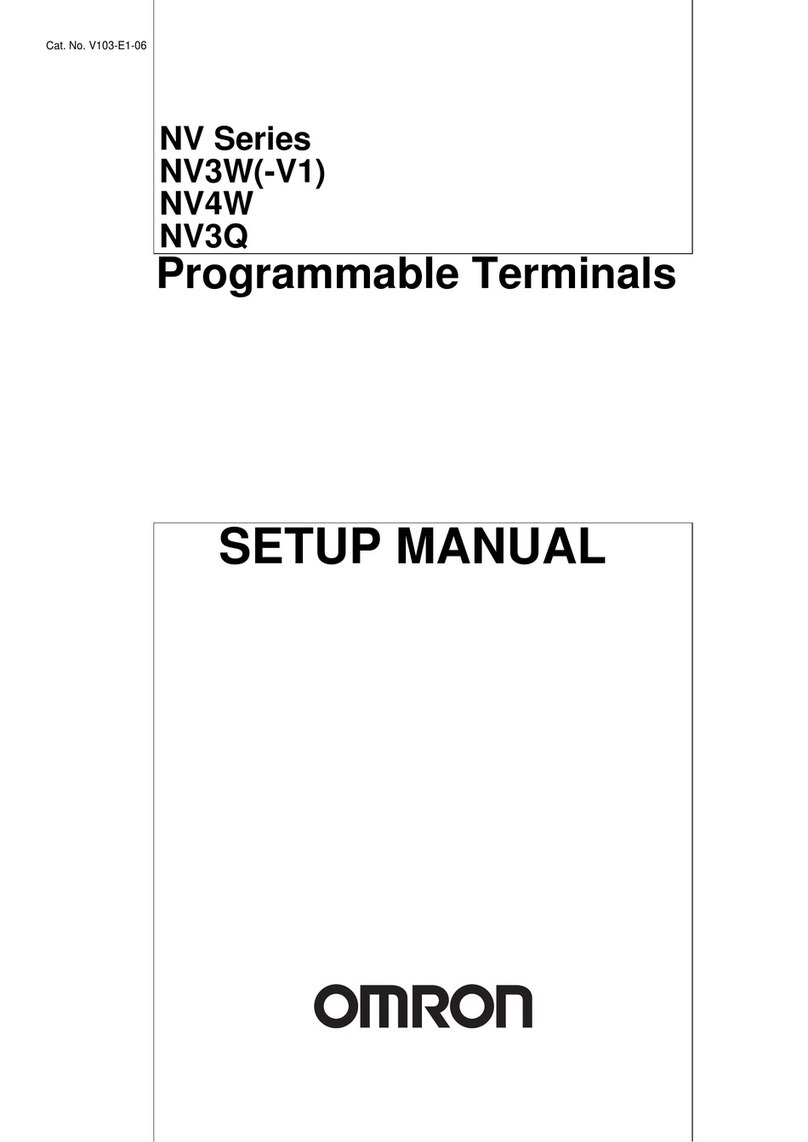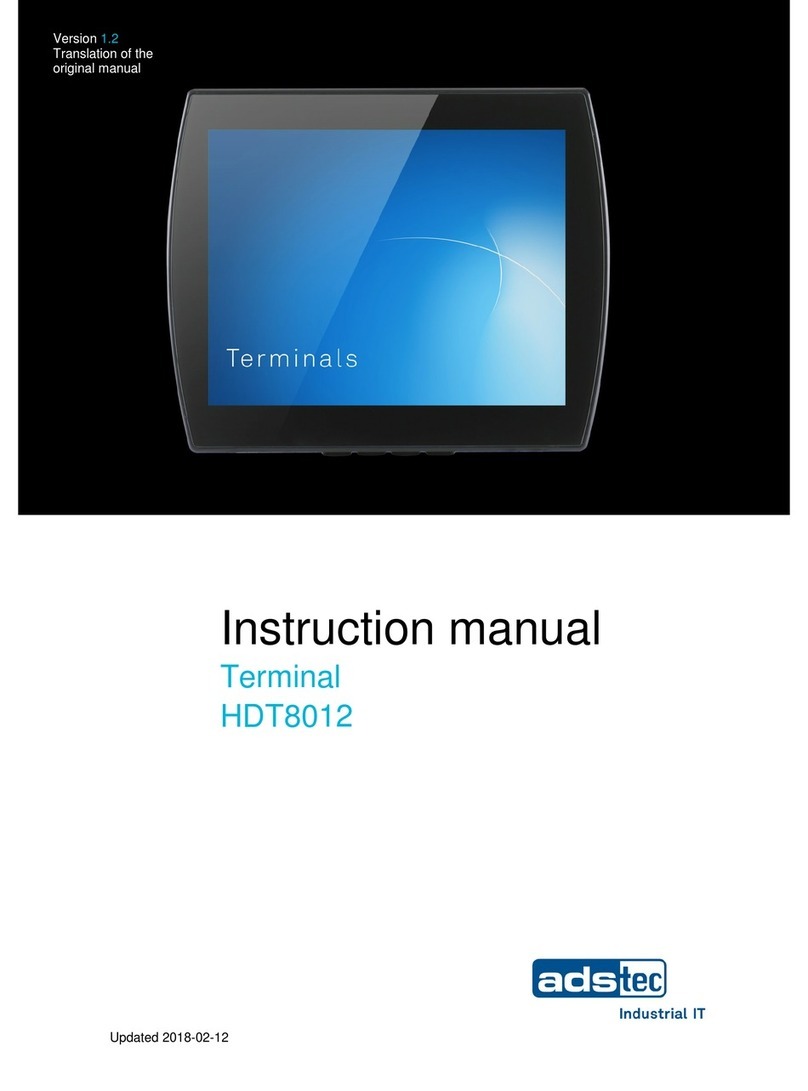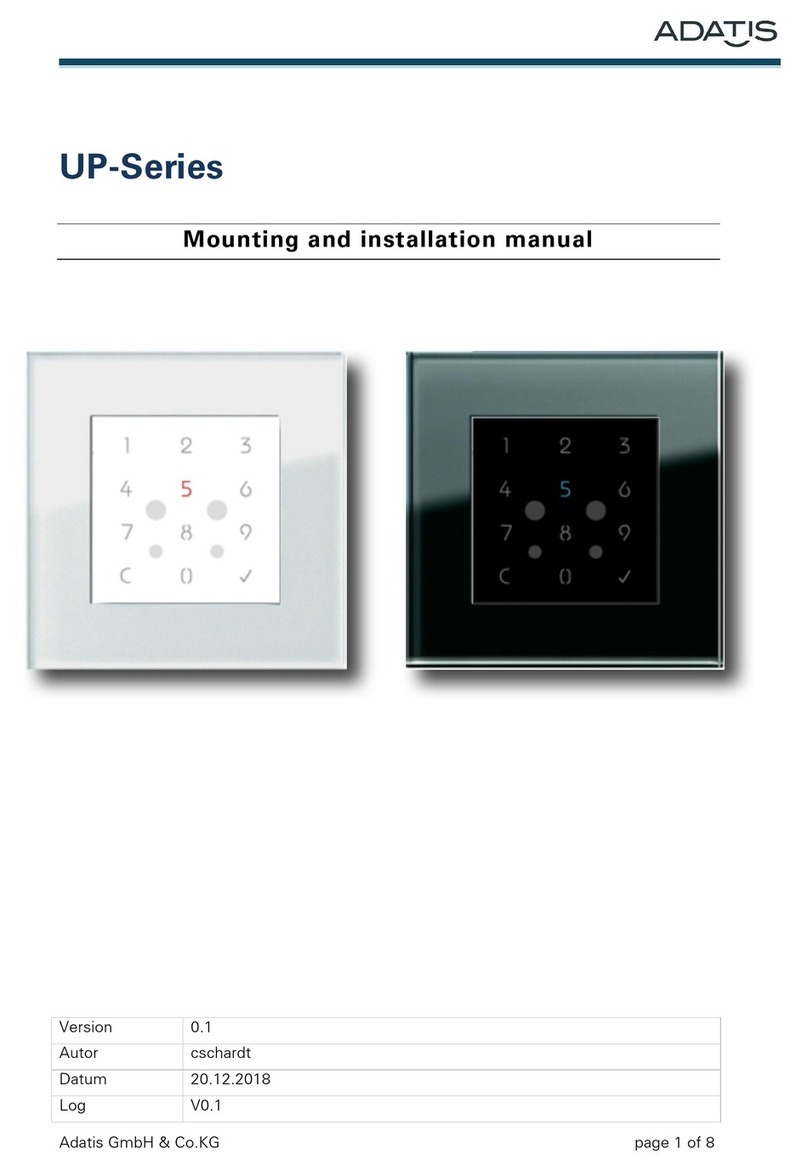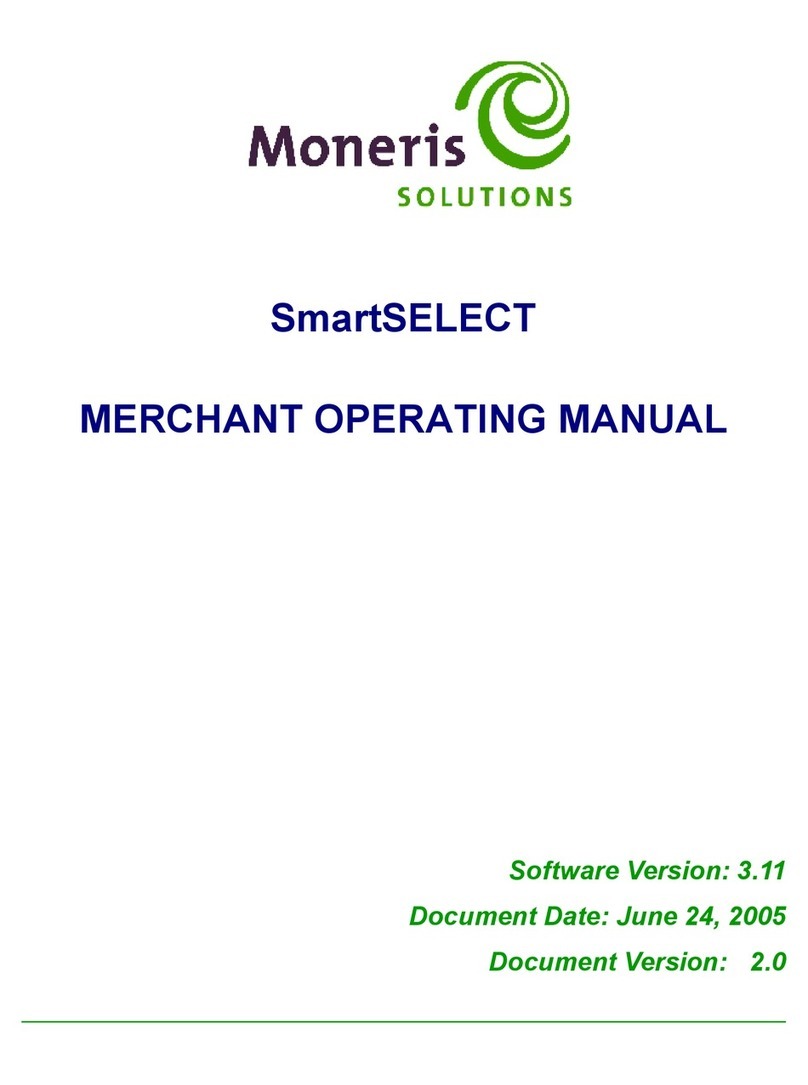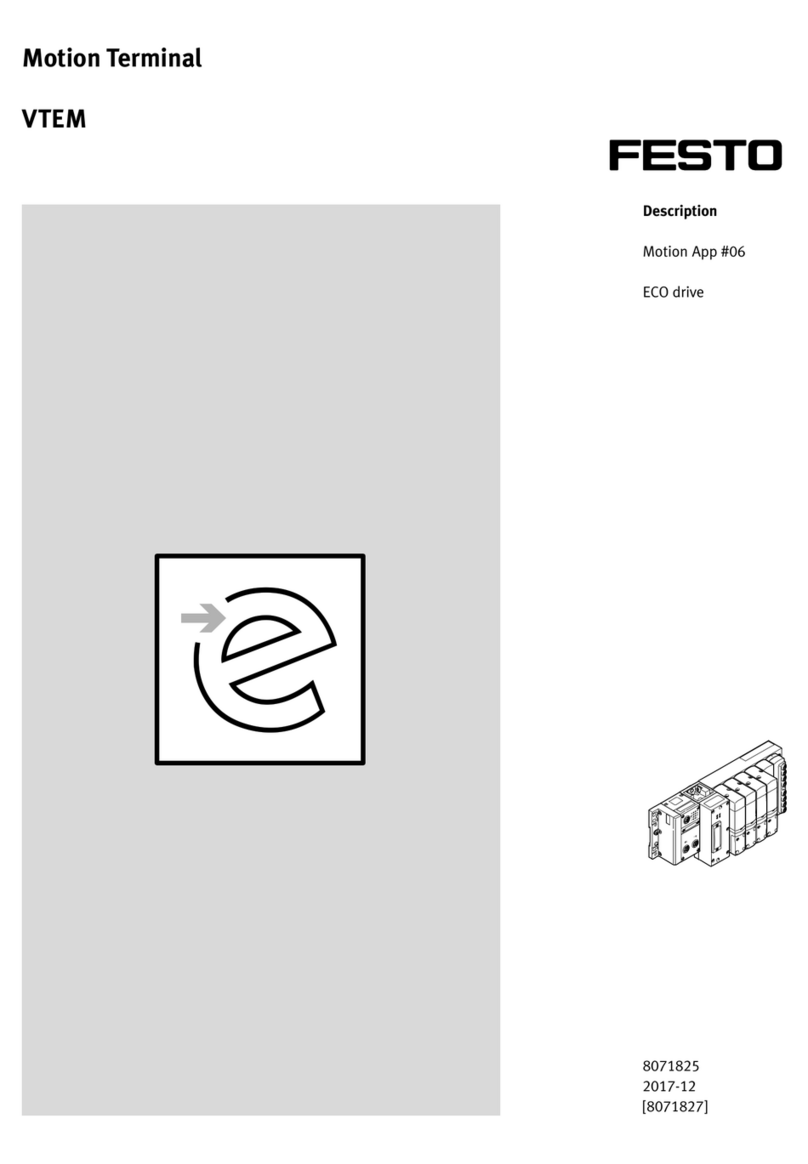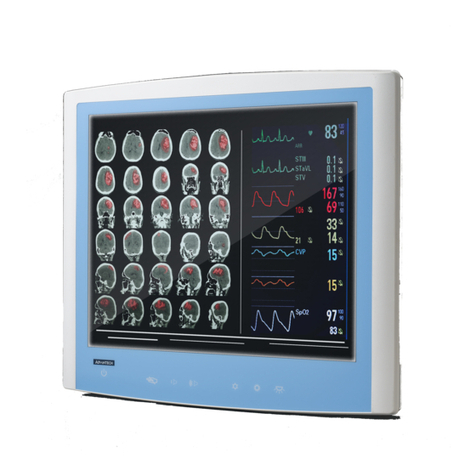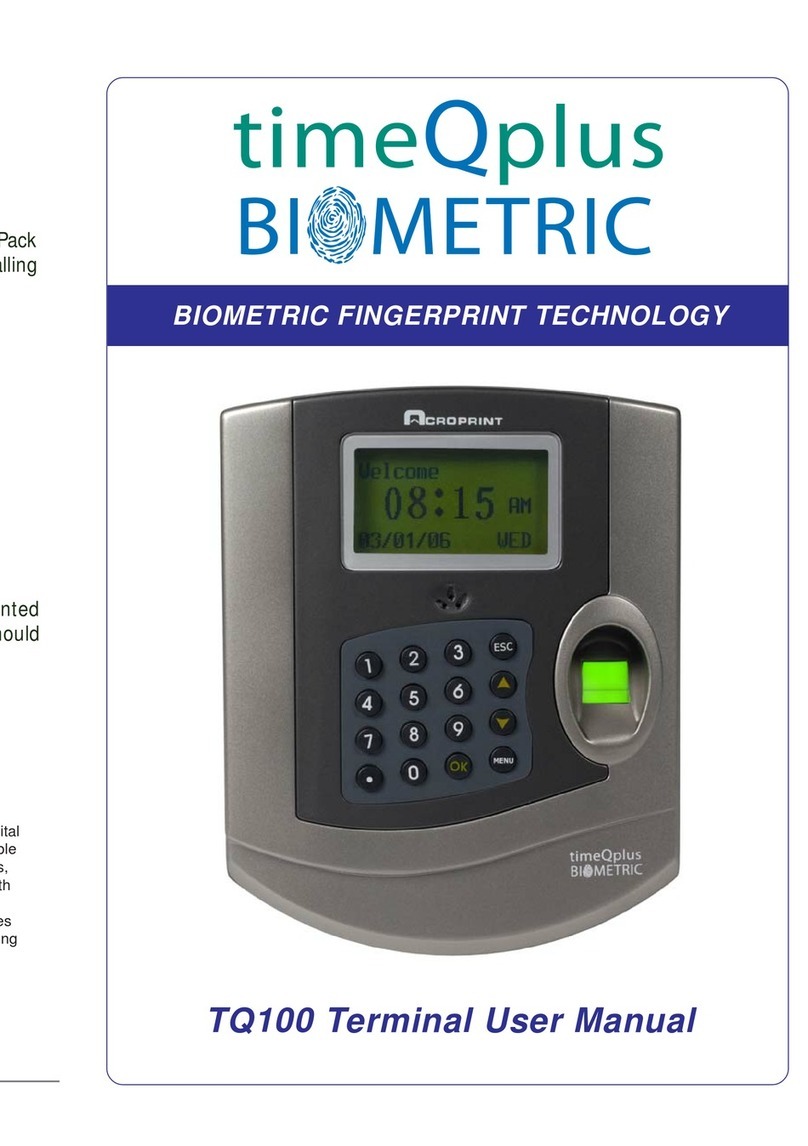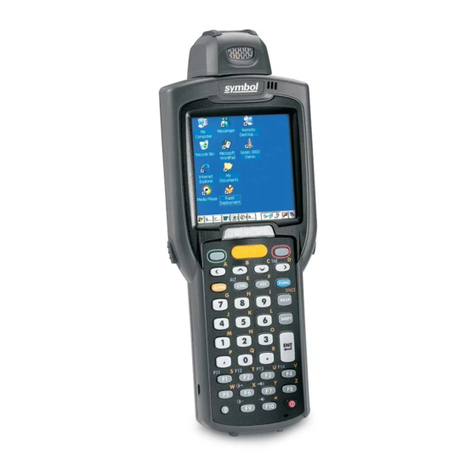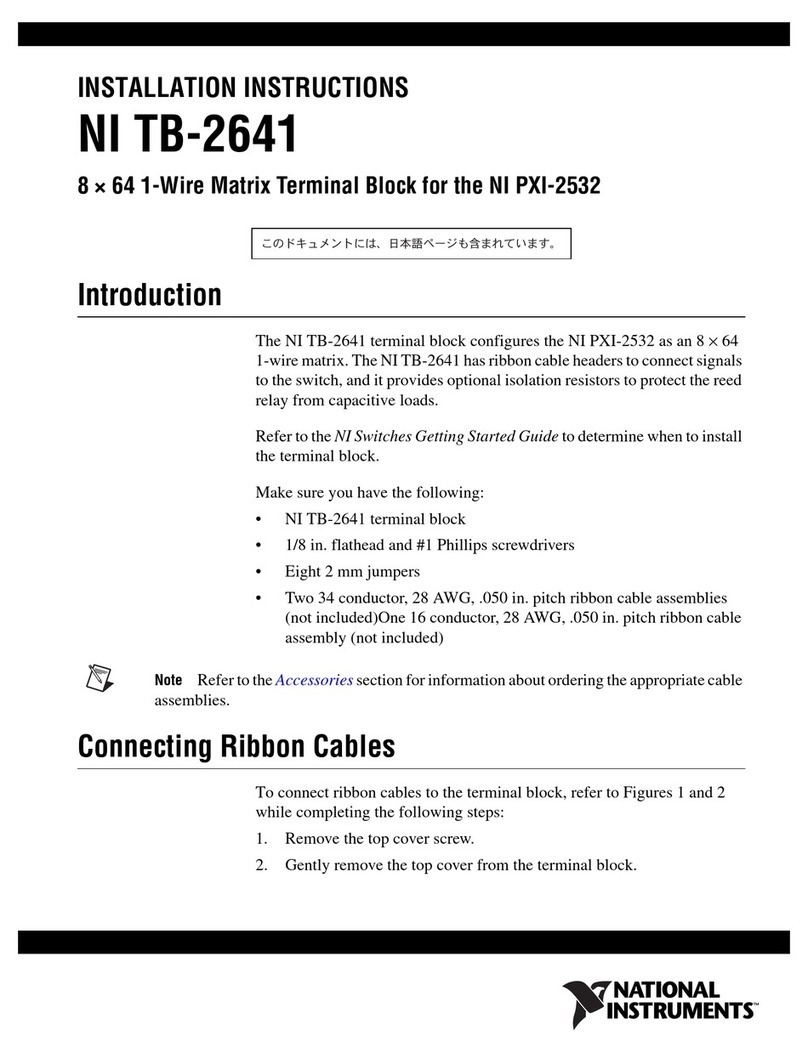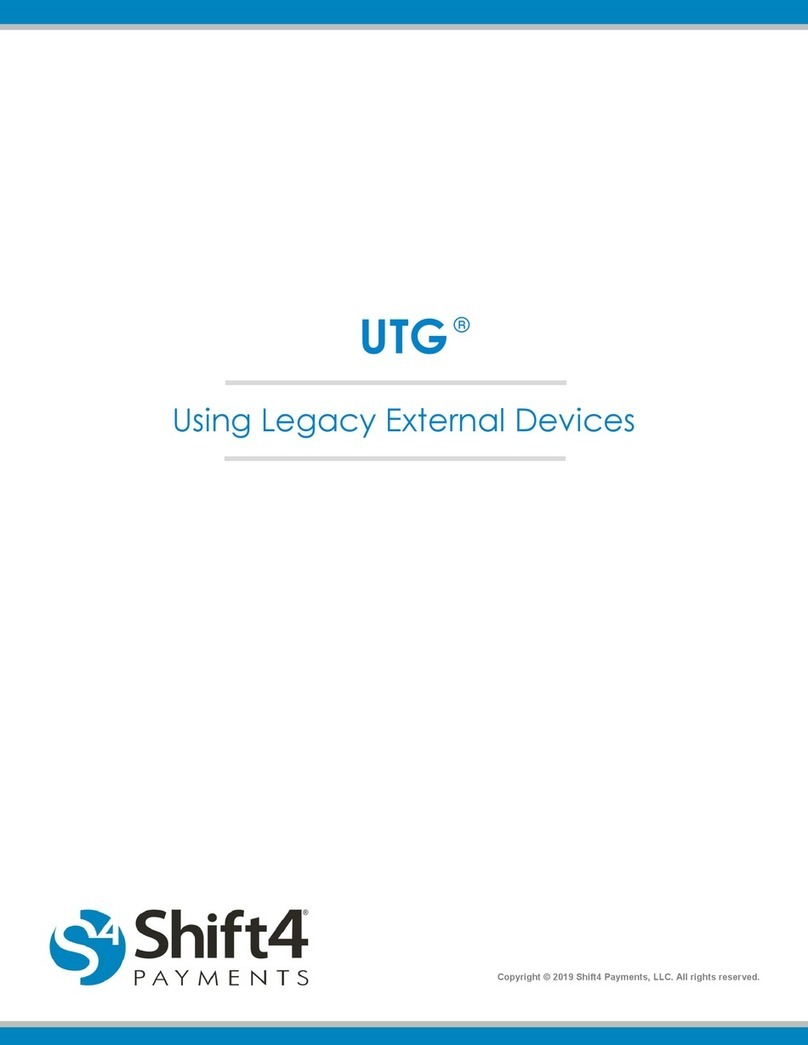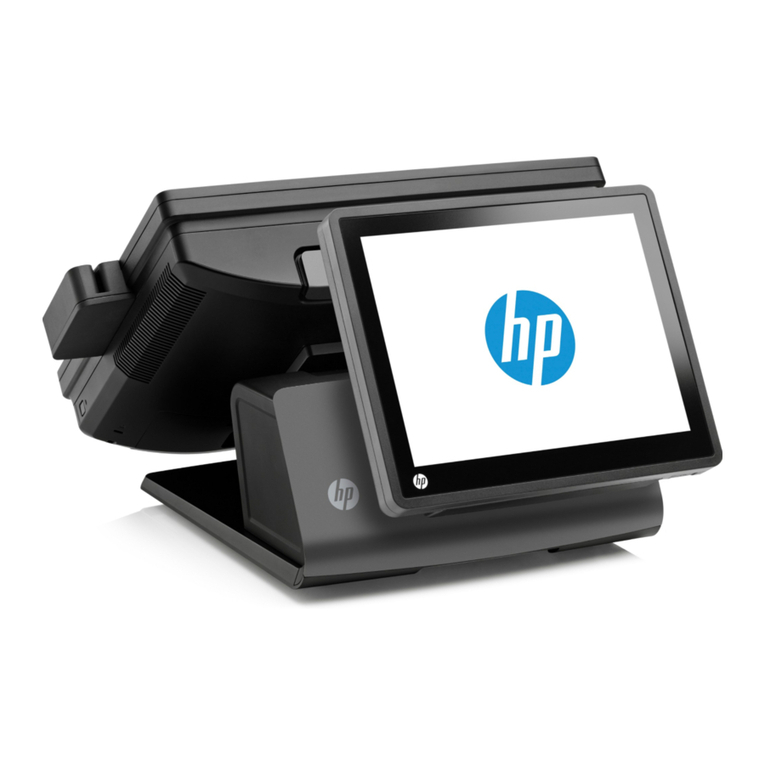Beckoff BC8000 User manual

RS485
Bus coupler BC8000
Version: 2.3
Last change: 2006-11-06

Contents
2 BC8000
Contents
1. Foreword 3
Notes on the documentation 3
Liability Conditions 3
Delivery conditions 3
Copyright 3
Safety Instructions 4
State at Delivery 4
Description of safety symbols 4
2. Basic information 5
Description of the BC8000 5
The Beckhoff bus terminal system 5
The interfaces 7
Power supply 7
Power supply to the power contacts 7
Power contacts 7
RS 485 Connection 9
K-bus contacts 9
Supply isolation 9
The operating modes of the bus coupler 10
Mechanical construction 11
Technical / PLC Data 13
The peripheral data in the process image 14
Starting operation and diagnostics 16
3. RS485 – Controller BC8000 18
System Introduction 18
Interface Programming 19
The Medium: Plugs and Cables 22
The User Programming Interface 23
Remanent Data 23
Persistent Data 23
4. Appendix 25
Example: Process image in the bus terminal controller 25
Representation of analog signals in the process image 27
Baud Rate Selection Table 28
Read out address 28
Programming Example 29
BC8000 as a Slave 31
General Information 31
TwinCAT as the Master 31
KS8000 as the Master 31
KS2000 Settings 32
Terminal Mapping 32
Firmware 33
5. Questions and Answers 33
General 33
No communication with the BC8x00 33
Mapping of the digital and the byte-oriented Bus Terminals onto a fixed
address 33
Drop of the digital outputs 33
Index 35
6. Support and Service 36
Beckhoff's branch offices and representatives 36
Beckhoff Headquarters 36

Foreword
BC8000 3
Foreword
Notes on the documentation
This description is only intended for the use of trained specialists in control and automation engineering
who are familiar with the applicable national standards. It is essential that the following notes and
explanations are followed when installing and commissioning these components.
Liability Conditions
The responsible staff must ensure that the application or use of the products described satisfy all the
requirements for safety, including all the relevant laws, regulations, guidelines and standards.
The documentation has been prepared with care. The products described are, however, constantly under
development. For that reason the documentation is not in every case checked for consistency with
performance data, standards or other characteristics. None of the statements of this manual represents a
guarantee (Garantie) in the meaning of § 443 BGB of the German Civil Code or a statement about the
contractually expected fitness for a particular purpose in the meaning of § 434 par. 1 sentence 1 BGB. In
the event that it contains technical or editorial errors, we retain the right to make alterations at any time
and without warning. No claims for the modification of products that have already been supplied may be
made on the basis of the data, diagrams and descriptions in this documentation.
Delivery conditions
In addition, the general delivery conditions of the company Beckhoff Automation GmbH apply.
Copyright
©
This documentation is copyrighted. Any reproduction or third party use of this publication, whether in
whole or in part, without the written permission of Beckhoff Automation GmbH, is forbidden.

Foreword
4 BC8000
Safety Instructions
State at Delivery
All the components are supplied in particular hardware and software configurations appropriate for the
application. Modifications to hardware or software configurations other than those described in the
documentation are not permitted, and nullify the liability of Beckhoff Automation GmbH.
Description of safety symbols
The following safety symbols are used in this documentation. They are intended to alert the reader to the
associated safety instructions..
Danger
This symbol is intended to highlight risks for the life or health of personnel.
Attention
This symbol is intended to highlight risks for equipment, materials or the
environment.
i
Note
This symbol indicates information that contributes to better understanding.

Basic information
BC8000 5
Basic information
Description of the BC8000
The bus terminal controller BC8000 is a bus coupler with integrated PLC
functionality. The controller is programmed in IEC 1131-3. Up to 64
terminals belonging to the Beckhoff bus terminal system can be connected
to the BC8000. These include analog signal types for current and voltage,
as well as PT100 and thermocouples, in addition to digital input and output
terminals. The serial interface of the bus terminal controller can be used for
connection to additional serial devices.
The Beckhoff bus terminal system
Up to 64 bus terminals
each with 2 I/O channels
for any form of signal
Decentralized wiring of the
I/O level
IPC as control unit
Bus couplers for all current
bus systems
Standard C rail assembly
Modularity
The bus terminal system is the universal connecting link between a
fieldbus system and the sensor/actor level. A unit consists of a bus coupler,
which is the interface to the fieldbus, and up to 64 electronic terminals, of
which the last is an end terminal. Terminals, each with two I/O channels,
are available for any form of technical signal and can be combined as
desired. The various types of terminal are all constructed in the same way,
so that the planning costs are kept extremely low. The height and depth of
the construction are calculated for compact terminal cabinets.
Fieldbus technology makes it possible to use compact control
architectures. The I/O level does not need to be taken right up to the
control unit. Sensors and actors can be connected decentrally with minimal
lengths of cable. You can position the control unit at any convenient
location in the installation. Using an industrial PC as control unit makes it
possible to implement the operating and monitoring element as part of the
control hardware, so the control unit can be located on an operating desk,
control point or similar. The bus terminals constitute the decentralized
input/output level of the control unit in the switch cabinet and its
subordinate terminal cabinets. As well as the sensor/actor level, the power
unit of the equipment is also controlled via the bus system. The bus
terminal replaces a conventional terminal as the cabling level in the switch
cabinet; the switch cabinet can be made smaller.
The Beckhoff bus terminal system combines the advantages of a bus
system with the functionality of compact terminals. Bus terminals can be
used on all current bus systems and serve to reduce the diversity of parts
in the control unit, while behaving like the conventional standard units for
the relevant bus system and supporting the entire range of functionality of
the bus system.
The simple and compact assembly on a standard C rail, and the direct
cabling of actors and sensors without cross connections between the
terminals, serve to standardize the installation, as does the uniformly
designed labeling.
The small size and great flexibility of the bus terminal system mean that
you can use it anywhere that you could use a terminal and use any type of
connection – analog, digital, serial or direct sensors.
The modular construction of the terminal row, using bus terminals with
various functions, limits the number of unused channels to at most one per
function. Two channels to a terminal is the optimum solution for the number
of unused channels and the cost per channel. The possibility of using
power input terminals to provide separate power supplies also helps to
minimize the number of unused channels.

Basic information
6 BC8000
Display of channel status
The integrated light-emitting diodes close to the sensor/actor indicate the
status of each channel.
The K-bus
End terminal
The K-bus is the path taken by data within the terminal row. The bus
coupler carries the K bus through all the terminals by means of six contacts
on the side walls of the terminals, and the end terminal terminates the K
bus. The user does not need to know anything about the function of the K
bus or the internal operation of terminals and bus couplers. There are
numerous software tools available which provide for convenient planning,
configuration and operation.
Power input terminals
for
Separately powered groups
Three power contacts pass the operating power to the following terminals.
You can use power input terminals to subdivide the terminal row as desired
into groups, each with a separate power supply. These power input
terminals are not taken into account for addressing the terminals, you can
insert them at any position along the terminal row.
You can install up to 64 terminals on a terminal row, including power input
terminals and the end terminal.
The principle of the bus
terminal
0201
+ +
PE PE
WD
RX
TX
PLC
RS 485
BECKHOFF
24V
0V
0
9
8
7
6
5
4
3
2
1
0
9
8
7
6
5
4
3
2
1
K bus
End terminal
Galvanic
is lati n
P tential
feed
terminal
P wer
c ntacts
RS485
bus c ntr ller
BC 8000
Supply v ltage
f r the
bus c ntr ller
Additional characteristics of
the bus terminal controllers
Bus terminal controllers (BC) differ from bus couplers (BK) in that, in
addition to K-bus processing, a real-time PLC task is also running. Unlike
bus couplers, the signals from the terminals are processed by the PLC
task, while the fieldbus carries the in- and outputs of the PLC task. It is
possible, however, to subdivide the terminals to that some terminals are
pre-processed by the PLC task, while others are sent directly over the
fieldbus to a supervising system.
Bus couplers for various
fieldbus systems
Various bus terminal controllers can be used to couple the electronic
terminal strip with integrated PLC task quickly and easily to different
fieldbus systems. It is also possible to convert to another fieldbus system at
a later time. The bus terminal controller performs all the monitoring and
control tasks that are necessary for operation of the connected bus
terminals. The operation and configuration of the bus terminals is carried
out exclusively by the bus terminal controller. Fieldbus, K-bus and I/O level
are galvanically isolated.

Basic information
BC8000 7
If data exchange over the fieldbus fails, the PLC task continues to run as
an autonomous system.
The interfaces
There are six ways of making a connection to a bus coupler. These
interfaces are designed as plug connections and spring terminals.
Serial controller RS485 -
BC8000
RS 485
RS 485
TX
RX
WD
PLC
P wer LEDs
bus c upler/p wer c ntacts
K bus
Bus c upler p wer supply 24 V
DC/GND
P wer c ntacts
feeding p ints
P wer c ntacts
Address
select r
BC8000
Power supply
24 V DC on the topmost
terminals
The bus couplers need an operating power of 24 V DC which is connected
via the topmost spring terminals, labeled "24 V” and "0 V”. This power
supply serves not only the electronic components of the bus coupler but
(via the K bus) also the bus terminals. The power supply of the bus coupler
circuitry and that of the K-bus (Terminal bus) are electrically isolated from
the voltage of the field level.
Power supply to the power contacts
Lower 3 terminal pairs for
power input
maximum 24 V
maximum 10 A
The six lower connections with spring terminals can be used to supply
power to the peripherals. The spring terminals are connected in pairs to the
power contacts. The power supply to the power contacts has no
connection to the power supply of the bus couplers. The power input is
designed to permit voltages up to 24 V. The pair-wise arrangement and the
electrical connection between the feed terminal contacts makes it possible
to loop through the wires connecting to different terminal points. The load
on the power contact may not continuously exceed 10 A. The current
capacity between two spring terminals is the same as the capacity of the
connecting wires.
Power contacts
Spring contacts at the side
On the right-hand side face of the bus coupler are three spring contacts
which are the power connections. The spring contacts are recessed in slots
to prevent them from being touched. When a bus terminal is connected,
the blade contacts on the left-hand side of the bus terminal are connected
to the spring contacts. The slot and key guides at the top and bottom of the
bus couplers and bus terminals ensure reliable location of the power
contacts.

Basic information
8 BC8000

Basic information
BC8000 9
RS 485 Connection
9 pole Sub-D female
connector strip
There is a recessed front surface on the left-hand side. A 9-pole Sub-D
connector can be plugged in here. A detailed description of the RS485
interface can be found in a further part of this manual (chapter entitled 'The
media: plugs and cable').
K-bus contacts
6 contacts at the side
The connections between the bus coupler and the bus terminals are
effected by gold contacts at the right-hand side of the bus coupler. When
the bus terminals are plugged together, these gold contacts automatically
complete the connection to the bus terminals. The K bus is responsible for
the power supply to the electronic components of the K bus in the bus
terminals, and for the exchange of data between the bus coupler and the
bus terminals. Part of the data exchange takes place via a ring structure
within the K bus. Disengaging the K bus, for example by pulling on one the
bus terminals, will break this circuit so that data can no longer be
exchanged. However, there are mechanisms in place which enable the bus
coupler to locate the interruption and report it.
Supply isolation
3 supply groups:
fieldbus
K-bus
peripheral level
The bus couplers operate with three independent supplies. The input
power supplies the electrically isolated K-bus circuitry in the bus coupler
and the K-bus itself. The power supply is also used to generate the
operating power for the fieldbus.
Note: All the bus terminals are electrically isolated from the K bus, so that
the K-bus is completely electrically isolated.
Setting up the power levels
in the bus terminal system
Periphery level
Bus terminals
Bus c upler
Field bus
24 V DC
Terminal bus

Basic information
10 BC8000
The operating modes of the bus coupler
When it is first switched on the bus coupler carries out a self-test to check
the functions of its components and the communications of the K bus, and
while this is going on the red I/O LED will flash. When the self-test has
been completed successfully, the bus coupler will begin to test the
attached bus terminals (the "bus terminal test”) and read in the
configuration from which it constructs an internal structure list, which is not
accessible from outside. If an error occurs the bus coupler will enter the
operating mode "STOP”. If the start-up sequence is completed without
errors the bus coupler will enter the mode "fieldbus start”.
Start-up behaviour of the
bus coupler
The bus coupler reports the error to the master by means of the Profibus
diagnostics. Clearing the error returns the bus coupler to its normal
operating mode.
Power on selltest
Bus terminal test
Structure list
listlis
PLC start/
Communication start
Stop
OK
Error

Basic information
BC8000 11
Mechanical construction
The Beckhoff bus terminal system is remarkable for its compact
construction and high degree of modularity. When you design the
installation you will need to plan for one bus coupler and some number of
bus terminals. The dimensions of the bus couplers do not depend on the
fieldbus system. If you use large plugs, for example like some of the bus
plugs used for the Profibus, they may protrude above the overall height of
the cabinet.
Dimensions of a bus
coupler
RS 485
PLC
WD
RX
TX
BC8000
The overall width of the construction is the width of the bus coupler,
including the bus end terminal, plus the width of the installed bus terminals.
The bus terminals are 12 mm or 24 mm wide, depending on their function.
Depending on the gauge of cables used the overall height of 68 mm may
be overstepped by about 5 mm to 10 mm by the cables at the front.
Assembly and link
It takes only a slight pressure to latch the bus coupler and the various bus
terminals onto a supporting 35mm C rail and a locking mechanism then
prevents the individual housings from being removed. You can remove
them without effort if you first release the latching mechanism by pulling the
orange tab. You should carry out work on the bus terminals and the bus
coupler only while they are switched off: if you plug or unplug components
while the power is on you may briefly provoke some undefined state (and,
for instance, reset the bus coupler).
You can attach up to 64 bus terminals in series on the right-hand side of
the bus coupler. When you assemble the components, make sure that you
mount the housings so that each slot comes together with the
corresponding key. You cannot make any functional connections merely by
pushing the housings together along the supporting track. When they are
correctly mounted there should be no appreciable gap between the
adjacent housings.
The right-hand side of a bus coupler is mechanically similar to a bus
terminal. There are eight connections on the top which can be used to
connect to thick-wire or thin-wire lines. The connection terminals are spring
loaded. You open a spring terminal by applying a slight pressure with a
screwdriver or other pointed tool in the opening above the terminal and you
can then insert the wire into the terminal without any obstruction. When you
release the pressure the terminal will automatically close and hold the wire
securely and permanently.

Basic information
12 BC8000
Insulation test
PE power contacts
The connection between bus couplers and bus terminals is automatically
effected by latching the components together. The K bus is responsible for
passing data and power to the electronic components of the bus terminals.
In the case of digital bus terminals, the field logic receives power via the
power contacts. Latching the components together has the effect that the
series of power contacts constitutes a continuous power track. Please refer
to the circuit diagrams of the bus terminals: some bus terminals do not loop
these power contacts through, or not completely (e.g. analog bus terminals
or 4-channel digital bus terminals). Each power input terminal interrupts the
series of power contacts and constitutes the beginning of a new track. The
bus coupler can also be used to supply power to the power contacts.
The power contact labeled "PE” can be used as protective earth or ground.
This contact stands proud for safety reasons and can carry short-circuit
currents of up to 125A. Note that in the interests of electromagnetic
compatibility the PE contacts are capacitively connected to the supporting
track. This may lead to spurious results and even damage to the terminal
when you test the insulation (e.g. insulation test for breakdown using a
230V mains supply to the PE line). You should therefore disconnect the PE
line on the bus coupler while you carry out insulation tests. You can
disconnect other power supply points for the duration of the test by drawing
the power supply terminals out from the remaining row of terminals by at
least 10mm. If you do this, there will be no need to disconnect the PE
connections.
The protective earth power contact ("PE”) may not be used for any other
connections.

Basic information
BC8000 13
Technical / PLC Data
The electrical data of the RS485 bus terminal controller are presented in
this chapter. The bus terminal controller is set to 19,200 baud data rate.
Addresses from 0 to 99 are selectable via two address selectors on the
coupler. The following table gives an overview of all the data:
Technical data BC8000
Number of bus terminals 64
Digital
peripheral signals
256 inputs and outputs
Analogue peripheral signals 128 inputs and outputs
Peripheral bytes 512 inputs and 512 outputs
Electrical power supply 24 V (- 15% / +20%) EN 61131
Input current 70 mA + (total K bus current)/4
500 mA max.
Power-on surge 2.5 x steady operating current
K-bus output current 1750 mA max.
Connector 1 x D-sub plug, 9-pin
Voltage of the power contact 24 V DC / AC
Power contacts current
drawn
10 A
Voltage stability 500 Veff (power contact / supply voltage)
Typical weight 170 g
Operating temperature 0°C ... +55°C
Storage temperature -25°C ... +85°C
Relative humidity 95% without dew formation
Vibration/shock stability according to IEC 68-2-6 / IEC 68-2-27
EMC immunity, burst / ESD according to EN 61000-4-4 / EN 61000-4-2, limit values in accordance with
EN 50082-2
Installation location arbitrary
Protection class IP20
PLC data
Programmability via programming interface or RS485 interface (TwinCAT BC/TwinCAT)
Program size approx. 3000 PLC statements
Program memory 32 kbytes / 96 kbytes
Data storage 32 kbytes / 64 kbytes
Remanent flags 512 bytes
Runtime system 1 PLC task
PLC cycle time approx. 3 ms for 1000 instructions (including K-bus I/O cycle)
Programming languages IL, LD, FBD, SFC, ST
Station addresses Selectable to 99 via DIP switch
0: reserved
1 – 98: programming mode
99: interface available for the PLC program
Interface RS485
Baud rate 19,200 baud, 8 data bits, even parity, one stop bit
Current consumption on the
K-bus
For operation of the K-bus electronics, the bus terminals require energy
from the K-bus that is supplied by the bus coupler. Refer to the catalog or
the corresponding data sheets of the bus terminals for details of the K-bus
current consumption. In doing so, pay attention to the maximum output
current of the bus coupler that is available for powering the bus terminals.
Using a special power supply terminal (KL9400), power can be fed back
into the K-bus at any chosen point. If you wish to use a power supply
terminal, please contact Beckhoff’s technical support.

Basic information
14 BC8000
The peripheral data in the process image
When the bus coupler is first switched on it determines the configuration of
the attached input/output terminals and automatically assigns the physical
slots of the input/output channels to the addresses in the process image.
The bus coupler sets up an internal list of assignments in which each of the
input and output channels has a specific position in the process image. A
distinction is made here between input and output and between bit-oriented
(digital) and byte-oriented (analog, or complex) signal processing.
It also forms two groups, whereby one contains only inputs and the other
only outputs. In each group, the byte-oriented channels take the lowest
addresses, in ascending order, and these are then followed by the bit-
oriented channels.
Digital signals
(bit-oriented)
Digital signals are bit-oriented. This means that one bit of the process
image is assigned to each digital channel. The bus coupler sets up a block
of memory containing the current input bits and arranges to immediately
write out the bits from a second block of memory which belongs to the
output channels.
The precise assignment of the input and output channels to the process
image of the control unit is explained in detail in the Appendix by means of
an example.
Analog signals
(byte-oriented)
The processing of analog signals is always byte-oriented and analog input
and output values are stored in memory in a two-byte representation. The
values are held as "SIGNED INTEGER” or "twos-complement”. The digit
"0” represents the input/output value "0V”, "0mA” or "4mA”. When you use
the default settings, the maximum value of the input/output value is given
by "7FFF” hex. Negative input/output values, such as -10V, are
represented as "8000” hex and intermediate values are correspondingly
proportional to one another. The full range of 15-bit resolution is not
realized at every input/output level. If you have an actual resolution of 12
bits, the remaining three bits have no effect on output and are read as "0”
on input. Each channel also possesses a control and status byte in the
lowest value byte. If the control/status byte is mapped in the control unit
has to be configured in the master configuration software. An analog
channel is represented by 2 bytes user data in the process image.
Word alignment In assigning peripheral signals to the process image of the PLC task and to
the fieldbus process image (depending on fieldbus), the analog and special
signals are mapped with word alignment.
Special signals and
interface
A bus coupler supports bus terminals with additional interfaces, such as
RS232, RS485, incremental encoder, etc.. These signals can be regarded
in the same way as the analog signals described above. A 16-bit data
width may not be sufficient for all such special signals; the bus coupler can
support any data width.
Default assignment of
inputs and outputs to the
process image
When the bus coupler is first switched on it determines the number of
attached bus terminals and sets up a list of assignments. This list
distinguishes between analog channels and digital channels and between
input and output; which are grouped separately. The assignments begin
immediately to the left of the bus coupler. The software in the bus coupler
creates the assignment list by collecting the entries for the individual
channels one at a time, counting from left to right. These assignments
distinguish four groups:

Basic information
BC8000 15
Function type of the channel Assignment level
1. Analog outputs byte-wise assignment
2. Digital outputs bit-wise assignment
3. Analog inputs byte-wise assignment
4 Digital inputs bit-wise assignment
Analog inputs/ouputs are representative of other complex multi-byte signal
bus terminals (RS485, SSI sensor interface, ...)
Overview of the subdivision of the process image in the bus coupler:
Output data in the bus
coupler
O0
...
byte-oriented data
...
Ox
Ox+1
bit-oriented data
Ox+y
Input data in the bus
coupler
I0
...
byte-oriented data
...
Ix
Ix+1
...
bit-oriented data
...
Ix+y
The way from I/Os to the
process image in the
application software
The bus coupler automatically assigns the I/Os of the terminals to the
process image in the RS485 communication protocol. These allocations
can be modified with the Beckhoff KS2000 configuration software. Various
mapping parameters (e.g. Motorola/Intel format) can be set in the bus
coupler.
Processing complex signals
Data which contains no contradictions is said to be consistent. The
following consistency is required here: 1. The high byte and low byte of an
analog value (word consistency), 2. The control/status byte and the
corresponding parameter word for accessing the register. The interaction
of the peripherals with the control unit means that data can initially be
guaranteed consistent only within an individual byte: the bits which make
up a byte are read in together, or written out together. Byte-wise
consistency is quite adequate for processing digital signals but is not
sufficient for transferring values longer than eight bits, such as analog
values. The various bus systems guarantee consistency to the required
length. It is important to use the appropriate procedure for importing this
consistent data from the master bus system to the control unit. The
protocol for communication with the BC8000 always exchanges the
coupler's complete process image, thus ensuring data consistency.
Processing complex signals
All byte-oriented signal channels such as RS232, RS485 and incremental
encoder, can use byte lengths greater than two. Apart from the actual
difference in length, the procedure is always comparable with that for
analog signals

Basic information
16 BC8000
Starting operation and diagnostics
When the bus coupler is first switched on it at once checks the attached
configuration. A correct start-up procedure is indicated by the red LED "I/O
ERR” going out. If this LED flashes, this indicates a fault somewhere in the
terminals. You can determine the actual error code by observing the speed
of flashing and number of flashes. This will enable you to clear the fault
quickly.
The diagnostic LEDs The bus coupler has two groups of LEDs to provide a status display. The
top group of 4 LEDs indicates the status of the respective field bus. In the
case of the BC8000, various data transfer communication states are
displayed.
There are two further green LEDs on the top right side of the bus coupler to
display the supply voltage. The left LED displays the bus coupler's 24 V
power supply. The right LED signals the power supply to the Power
contacts.
Local errors Two LEDs, the "I/O LEDs”, which are situated below the fieldbus status
LEDs described above, are used to display the operating mode of the bus
terminals and the connection to these bus terminals. The green LED lights
up to indicate error-free operation, where "error-free” implies that
communication with the fieldbus system is also operating correctly. The red
LED flashes at two different rates to indicate a fault, whereby the specific
error is encoded in the pattern of flashes, as follows.
Flashing code
Fast flashing Start of the error code
First slow sequence Error code
Second slow sequence Error argument
Error code Error argument Description
1 pulse 0
1
2
EEPROM checksum error
In line code buffer overflow
Unknown data type
2 pulses
0
n (n > 0)
Programmed configuration
Invalid table entry/bus coupler
Invalid table comparison (terminal n)
3 pulses 0 Terminal bus command error
4 pulses 0
n
Terminal bus data error
Breakage after terminal n (0: coupler)
5 pulses n Terminal bus error during register
communication with terminal n
7 pulses 0 PLC time to long
9 pulses 0
n (n>0)
Checksum error in program flash memory
Terminal n is not consistent with the
configuration that existed at boot image
entry
The number of pulses (n) indicates the position of the last bus terminal
before the error. Passive bus terminals such as an infeed terminal, for
example, are not counted.
In the case of some errors, the bus coupler does not end the flashing
sequence when the error is remedied. The bus coupler's operating state
remains 'Stop'. The bus coupler can only be restarted by switching the
supply voltage off and on or by means of a software reset. It is only
permitted to remove and to plug in bus terminals in the network after
deactivation. The electronic circuitry of the bus terminals and of the bus
coupler is largely protected against destruction, but malfunctions and

BC8000 17
damage cannot be ruled out when devices are plugged together while live.
The occurrence of an error during ongoing operation does not immediately
trigger output of the error code via the LEDs. The bus coupler must be
requested to diagnose the bus terminals. The diagnostic request is
generated after switching on or at the request of the master.
Communication errors The top four LEDs show the operating states of RS485 communication.
The two bottom LEDs indicate local communication between the bus
coupler and bus terminals (as explained above).
The I/O RUN LED is controlled by the PLC in the synchronous state. The 3
communications LEDs indicate the state of the RS485 transmission. The
operating conditions are indicated by the „WD,“ „RX“ and „TX“ LEDs.
PLC-RUN The green PLC LED on the bus terminal controller lights up when the PLC
task is in the RUN mode.
WD
RX
TX
PLC
RS485
LED Operating state
WD off Controller operating as master.
RX blinks,
flickers
The bus terminal controller is receiving data via the
interface.
TX blinks,
flickers
The bus terminal controller is sending data over the
serial interface.
PLC lights up,
blinks
PLC task is in RUN mode
Creating boot image
The green I/O LED lights up in connection with access to the internal K
bus. However, the bus coupler queries the configuration of the bus
terminals after switching on and does not exchange any data with the
terminals. That is to say, the red I/O LED goes off after an error-free
startup without the green I/O LED having to light up. Then, the green I/O
LED does not light up until data transfer is commenced (see above).

RS485 – Controller BC8000
18 BC8000
RS485 – Controller BC8000
System Introduction
General
The BC8000 bus terminal controller allows assembly of a simple peer-to-
peer connection based on RS485 transmission. Connection for
programming the RS485 controller is established via the serial port on the
PC.
The controller can be programmed per programming standard IEC 1131-3
using TwinCAT BC or TwinCAT software.
There are two different operating modes for the BC8000. These are
selected via the address selection switches.
Address selection 99:
Master operation
RS485
BC8000
RS485 connection
External RS485 device
BC8000
An additional, external device is connected to the RS485 port of the
BC8000. It could be a display, barcode scanner, BK8000 or similar device.
Address selection 1-98:
Programming mode
RS485
BC8000
RS485 connection
PC BC8000
or programming cable to the configuration port of the BC8000
RS485
RS232
The BC8000 is programmed in this mode. There are two possible
transmission paths:
1. The RS485 interface of the bus terminal controller.
The description of the RS485 interface and of the cable is described in
the chapter „The Medium: Cables and Plugs“.
2. The configuration interface of the bus terminal controller.
A special cable is required (included with TwinCAT BC).
Address selection •Address 0:
•Address 1-98:
•Address 99:
Reserved
Programming mode
The interface is available for the PLC program.
Master operating mode of the BC8000.

RS485 – Controller BC8000
BC8000 19
If the serial interface on the bus terminal controller is not used for master
mode operation, the following chapter may be skipped.
Interface Programming
As described above, the RS485 interface of the BC8000 cannot be used
simultaneously for programming and for communication with an external
device. Hence as a first step the external device will be connected to a
serial communication terminal KL6001. After programming, this terminal is
removed and a KL6001 terminal emulation can be started. This emulation is
the RS485 interface of the BC8000.
Programming Instructions In order to simplify the process of programming the interface, a flow
diagram has been prepared to make the sequence clear. To orient you, you
will find portions of this diagram repeated in the margin.
KL6001 operation
For programming a KL6001 is used in order to be able to monitor the
communication with the external serial device. The terminal must be
entered in the controller as standard format and with 5 bytes of user data,
as emulation requires this format. In order to shift the terminal, one may
either use KS2000 software or order a parameterised terminal (Order
designation KL6001-0020). The terminal is situated in the process image of
the controller (e.g. at %QB0 and %IB0 if it is plugged in as the first byte-
oriented terminal – see appendix).

RS485 – Controller BC8000
20 BC8000
The emulation of the serial interface of the BC8000 behaves like a KL6001
and is therefore programmed in exactly the same way. Further information
can be found in the configuration instructions of the KL6001. Once
programming is successfully completed, the terminal can be removed. It
must be noted that the address of the terminal in the emulation must be
changed (emulation address: %IB500..505 and %QB500..505). The
emulation becomes active as soon as the address selector switch is set to
„99“ and the bus terminal controller is restarted.
Input Output
KL6001 emulation
%IB500 Status byte
%IB501 Data in 0
%IB502 Data in 1
%IB503 Data in 2
%IB504 Data in 3
%IB505 Data in 4
%QB500 Control byte
%QB501 Data out 0
%QB502 Data out 1
%QB503 Data out 2
%QB504 Data out 3
%QB505 Data out 4
The table shows the mapping of the interface emulation of the bus terminal
controller. The KL6001-0020 is exactly the same, but at another address.
The terminal address depends on the socket position and on the other
connected terminals. The example in the appendix should clarify this.
RS485
BC8000
RS485 connection
External RS485 device
BC8000
PC
or programming cable to the configuration port of the BC8000
RS485 connection
KL6021-0020
RS485
RS232
Control byte in process
data exchange
The control byte is transmitted from the terminal to the controller. For
setting up data exchange (handshake), the control and the status byte are
used in process data exchange.
Table of contents
